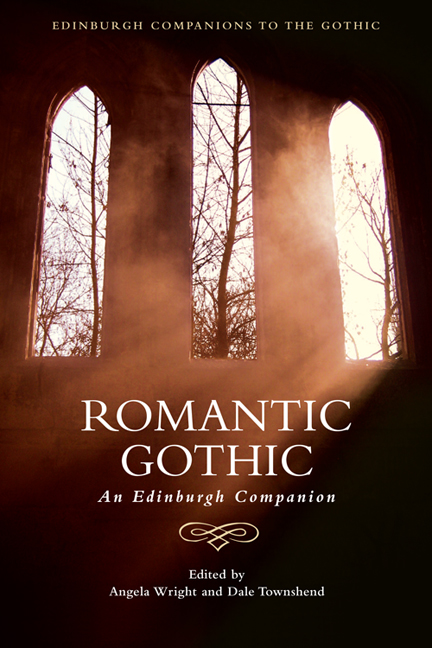Book contents
- Frontmatter
- Contents
- 1 Gothic and Romantic: An Historical Overview
- Part I Gothic Modes and Forms
- 2 Graveyard Writing and the Rise of the Gothic
- 3 Gothic Romance
- 4 The Gothic Stage: Visions of Instability, Performances of Anxiety
- 5 Gothic Poetry and First-Generation Romanticism
- 6 Gothic and Second-Generation Romanticism: Lord Byron, P. B. Shelley, John Polidori and Mary Shelley
- 7 Political Gothic Fiction
- 8 Shorter Gothic Fictions: Ballads and Chapbooks, Tales and Fragments
- 9 Oriental Gothic
- 10 Gothic Parody
- Part II National and International Borders
- Part III Reading the Romantic Gothic
- Notes on Contributors
- Index
10 - Gothic Parody
from Part I - Gothic Modes and Forms
Published online by Cambridge University Press: 05 August 2016
- Frontmatter
- Contents
- 1 Gothic and Romantic: An Historical Overview
- Part I Gothic Modes and Forms
- 2 Graveyard Writing and the Rise of the Gothic
- 3 Gothic Romance
- 4 The Gothic Stage: Visions of Instability, Performances of Anxiety
- 5 Gothic Poetry and First-Generation Romanticism
- 6 Gothic and Second-Generation Romanticism: Lord Byron, P. B. Shelley, John Polidori and Mary Shelley
- 7 Political Gothic Fiction
- 8 Shorter Gothic Fictions: Ballads and Chapbooks, Tales and Fragments
- 9 Oriental Gothic
- 10 Gothic Parody
- Part II National and International Borders
- Part III Reading the Romantic Gothic
- Notes on Contributors
- Index
Summary
Parody and satire are not traditionally associated with the Romantic period, yet recent scholarship has begun to recognise how prevalent these forms were. As Marilyn Gaull asserts, parody ‘comes of age as a major comic expression during the Romantic period’ (Gaull 1976: 52); that is to say, it emerged as a dominant form during the period when Gothic literature was most popular. Gothic was a favourite target of parodists, who ridiculed it both as a style of writing and as a literary trend. Dozens of parodic Gothic novels were published during what has been termed the ‘first wave’ of the Gothic between the 1760s and the 1830s. Gothic parody also found expression in poetry, plays, short stories, cartoons and essays. Parodists and other critics may have insisted that their targets were beneath contempt, worthy of being consigned to the oblivion of the ‘lumber-garret of a circulating library’, to quote Samuel Taylor Coleridge's review of The Monk (Coleridge 1797: 197), but the energy with which they carried out their attacks and the sheer number of parodies published are indications of the fascination and anxiety that Gothic elicited.
Although Eaton Stannard Barrett's The Heroine (1813), Thomas Love Peacock's Nightmare Abbey (1818) and Jane Austen's Northanger Abbey (1818) are still familiar to readers today, many Gothic parodies of the period have faded into obscurity, as have the texts that they targeted. They are long out of print and lie mouldering, not in ‘lumbergarrets’, but in rare-book collections. In this chapter, I provide a brief overview of some of the most notable parodies. I begin by considering the earliest examples, which were published even as Gothic was becoming established as a genre. I also discuss the tendency towards self-parody in founding Gothic texts and the blurry line separating ‘serious’ Gothic and Gothic parody. Next, I address how parodies were used to express aesthetic and ideological criticism in the turbulent decade of the 1790s, when Gothic was at its peak of popularity. Finally, I examine an important subgenre of Gothic parody, the Gothic Quixote tale, as a vehicle of literary and social satire. The chapter closes with some preliminary thoughts on the role of parodies in the history of Gothic literature.
- Type
- Chapter
- Information
- Romantic GothicAn Edinburgh Companion, pp. 185 - 204Publisher: Edinburgh University PressPrint publication year: 2015



